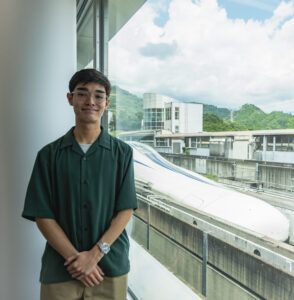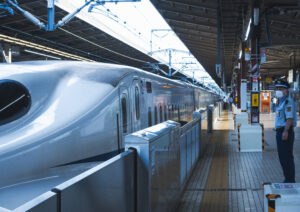 This was my third trip to Japan, not my first time. I attended some kindergarten and middle school in Tokyo and Fukuoka, but this was my first time going as an adult. I’m a senior at the University of Maryland, College Park where I major in PPE (Philosophy, Politics, and Economics) and minor in STEP (Science, Technology, Ethics, and Policy). My studies have me thinking about society in a broad way, how things are connected, and how we can work together to make progress. A lot of what we discuss about improving society in theory in school is already in practice in Japan.
This was my third trip to Japan, not my first time. I attended some kindergarten and middle school in Tokyo and Fukuoka, but this was my first time going as an adult. I’m a senior at the University of Maryland, College Park where I major in PPE (Philosophy, Politics, and Economics) and minor in STEP (Science, Technology, Ethics, and Policy). My studies have me thinking about society in a broad way, how things are connected, and how we can work together to make progress. A lot of what we discuss about improving society in theory in school is already in practice in Japan.
We met up with other Central Japan Rail (JRC) interns from Texas A&M University and University of Wisconsin-Madison, most of them with engineering backgrounds. We all came with a strong interest in the SCMAGLEV and the technology, but throughout our stay we became passionate about a lot more than just the tech. I was specifically looking forward to learning about the behind-the-scenes operations of JRC. Riding the subway, trains, and Shinkansen are an everyday activity for urban Japanese people, but most don’t get to see the gears turning. It’s a practically flawless system that gets you where you need to go, so most people don’t even think about how it all works!
engineering backgrounds. We all came with a strong interest in the SCMAGLEV and the technology, but throughout our stay we became passionate about a lot more than just the tech. I was specifically looking forward to learning about the behind-the-scenes operations of JRC. Riding the subway, trains, and Shinkansen are an everyday activity for urban Japanese people, but most don’t get to see the gears turning. It’s a practically flawless system that gets you where you need to go, so most people don’t even think about how it all works!
It was lots of fun (and incredibly exhausting) to visit so many cities and locations in just two weeks. We made stops in Shin-Yokohama, Shinagawa, Tokyo, Yamanashi, Mishima, Hamamatsu, Nagoya, Handa, and Kyoto. I made my own time to make a couple extra visits around Tokyo as well as Toyota City. The food is incredible, of course, and so cheap! I ate something new or something I had been missing a few times every day. Even still, there wasn’t enough time to experience everything I wanted to. Returning to the US, I felt more culture shock coming back to where I have lived most of my life. Japan has always felt like home because of the pervasive culture of respect and how accommodating the cities and infrastructure are. Even in the middle of summer, the most brutal season in Japan, it was still a comfortable and exciting place to be. I imagine that, even for someone who is visiting for the first time, they might feel the same. It’s such a clean, respectful, and accommodating society. Everyone is healthy, well-mannered, and well-dressed and it all stems from a culture of respect for yourself, others, and your environment. Everyone takes pride in their work, even the restroom janitors have a name-plate in the public restrooms.
 A strong focus on collaboration has built urban Japan into an integrated system designed to work for people, for cars, for trains, for businesses, and for housing. It’s all a big, well-organized mix that’s thought out to be practical and efficient. In cities, life revolves around the train stations as not only a means of transportation but also a destination for socializing, shopping, dining, business, and leisure. We stayed in hotels at the top of Shin-Yokohama and Nagoya stations with incredible views over the city. Everything we could ever need was within walking distance, and anything else was just a few stops away on the train.
A strong focus on collaboration has built urban Japan into an integrated system designed to work for people, for cars, for trains, for businesses, and for housing. It’s all a big, well-organized mix that’s thought out to be practical and efficient. In cities, life revolves around the train stations as not only a means of transportation but also a destination for socializing, shopping, dining, business, and leisure. We stayed in hotels at the top of Shin-Yokohama and Nagoya stations with incredible views over the city. Everything we could ever need was within walking distance, and anything else was just a few stops away on the train.
The American rail system and overall public infrastructure needs to change dramatically. Here in the US, rail is built for freight transportation, not for passenger transport, leaving cars as most people’s only transit options. Passenger transport like Amtrak and city metros are run by the government. Even with massive budgets that outsize Japan’s, we fail to expand, maintain, or even clean our public transit system. Japan’s public transit is run by a multitude of private companies that collaborate to provide many options and destinations for commuters. The privatization of the transit system has been extremely successful in urban areas and new stations and lines pop up frequently as companies see expanding transit options to be a lucrative business opportunity. Finally, safety and discipline are strongly emphasized in staff training and around the stations. JRC has a flawless record throughout over 50 years of service, no passenger deaths or injuries. Staff take pride in their jobs and in return they are provided with lifetime employment. In return, passengers treat the stations, trains, and staff with respect as well. Discipline and respect are infectious in Japan.
My biggest takeaways are the same thoughts as before I even arrived in Japan. That we, the US, are so far behind. Decades of neglecting our public infrastructure has held this country back and contributed to worsening inequality and lack of development and opportunities, especially for the disadvantaged. I’ve heard that the new American dream is to leave. My experience in Japan has further encouraged me to pursue a life abroad where life is safer, practical, affordable, and where there are more opportunities. If Americans want to fix what’s broken and give us something to be proud of, we need to invest in our own society and work hard to get ahead. The SCMAGLEV isn’t just a fast train. It’s literally about connecting our cities and communities in a practical and meaningful way to inspire growth and progress.
